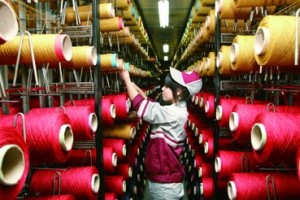Textiles Careers Background
 The word textile originally referred only to fabrics made by weaving yarn on a loom. Today, the textile industry includes knitted goods, braids, and other fabrics that are made from fibers, yarns, and other materials. Textiles may be made from natural products, such as cotton, linen, wool, and mohair, or from synthetic materials, such as polyester, nylon, and rayon. The textile industry produces fabrics for clothing, as well as fabrics for home furnishings, carpeting, towels, and sheets; ribbons, webbings, and tapes for automobile seat belts and conveyor belts; textiles for parachutes, fire-resistant and bullet-resistant uniforms; nonwoven olefin and polyester products to control erosion and reinforce highways; fabrics for disposable surgical masks, gowns, and sheets; and material to make tea bags, felt-tipped pens, camping gear, and disposable diapers.
The word textile originally referred only to fabrics made by weaving yarn on a loom. Today, the textile industry includes knitted goods, braids, and other fabrics that are made from fibers, yarns, and other materials. Textiles may be made from natural products, such as cotton, linen, wool, and mohair, or from synthetic materials, such as polyester, nylon, and rayon. The textile industry produces fabrics for clothing, as well as fabrics for home furnishings, carpeting, towels, and sheets; ribbons, webbings, and tapes for automobile seat belts and conveyor belts; textiles for parachutes, fire-resistant and bullet-resistant uniforms; nonwoven olefin and polyester products to control erosion and reinforce highways; fabrics for disposable surgical masks, gowns, and sheets; and material to make tea bags, felt-tipped pens, camping gear, and disposable diapers.
People began weaving the four basic natural fibers— cotton, linen, wool, and silk—into cloth as early as the Stone Age. Pieces of woven cloth dating from about 4000 BC have been discovered in Europe, Asia, South America, and the Middle East.
For a long time making cloth was a time-consuming task because everything had to be done by hand. When the industrial revolution began in the 18th century, textile manufacturing was one of the first industries affected by the development of the new machines. The machines used to produce textiles saved time and dramatically cut the cost of making clothing.
Until 200 years ago, the United States manufactured almost no cloth; most was imported from England. The textile industry was so important to England that English officials refused to allow either the drawings of textile machines or the mechanics who operated the machines to leave the country. In 1789, however, an English textile mechanic named Samuel Slater disguised himself as a farmer and sailed to the United States. He carried the details of the machinery in his head. A few years later, he opened a spinning mill in Rhode Island.
The first manufactured fibers were developed near the beginning of the 20th century. Since then, manufactured fibers have improved the function and versatility of textiles. For example, new fibers and finishes have made clothes less costly. Durable, soil-resistant synthetic carpets cover the floors of homes, schools, offices, and hospitals. The automotive industry uses these and other fibers in seat belts, upholstery, and the reinforcement of tires, belts, and hoses.
Although the textile industry in the United States began in the Northeast, the majority of plants are now in the Southeast. Roughly three out of three textile jobs are located in three states—Georgia, North Carolina, and South Carolina. The textile industry is one of the largest manufacturing industries in the United States, employing more than 416,000 workers in 2004. The combined textile and apparel industries employ 701,000 workers, according to the U.S. Department of Labor. The textile industry also is among the largest employers of minorities.
Fierce competition from overseas manufacturers has forced American textile companies to develop new technologies and processing methods. Computers have revolutionized the industry, speeding up such processes as knitting, weaving, and garment marking and cutting.